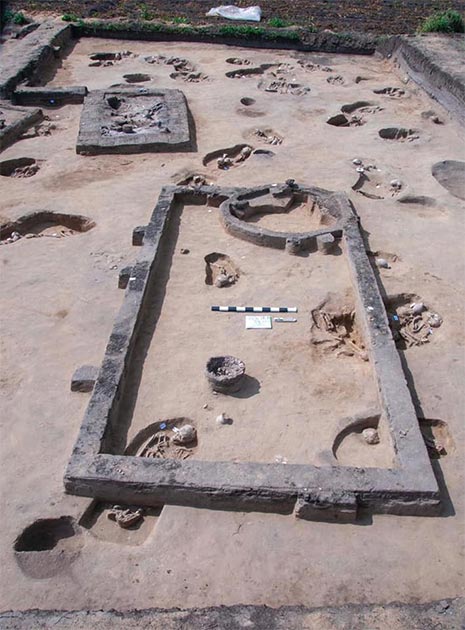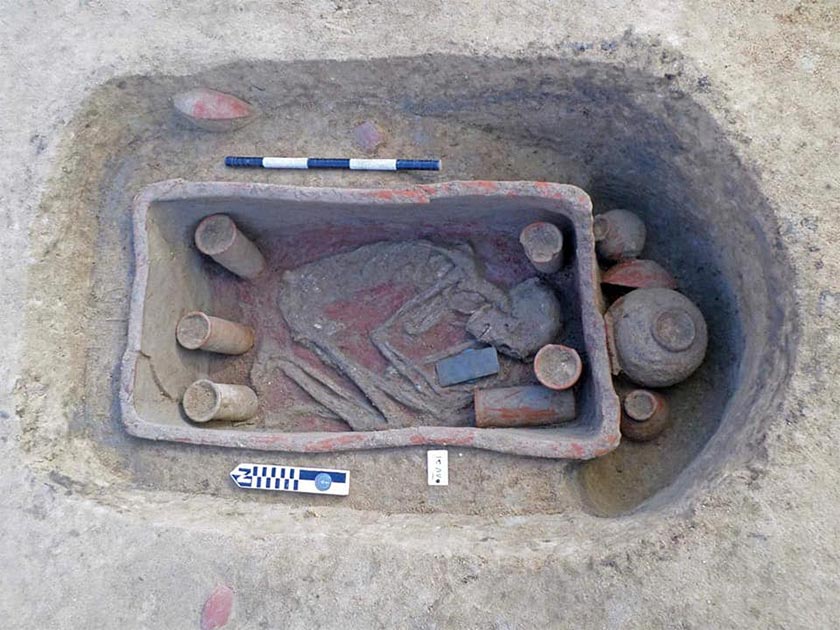Huge Predynastic Burial Ground Found in Egypt
In the north of Egypt, a major burial ground with 83 graves has been uncovered by archaeologists. The majority of the graves date back to the era before it was a unified kingdom ruled by the pharaohs. The find is helping researchers to understand cultures that were older than the pyramids and that possibly helped to lay the foundations for the Egyptian Old Kingdom (2575- 2150 BC).
A team of archaeologists working under the auspices of the Supreme Council of Antiquities, a government body, discovered the graves. Egypt Independent quotes a statement from the Egyptian Ministry of Tourism and Antiquities that they were found ‘during archaeological excavations in the Koam Al-Khiljan region of Egypt’s Daqahliya Governorate’, which is south-east of Alexandria.

Part of the burial ground found in Koam Al-Khiljan. (Ministry of Antiquities)
Mysterious Buto Culture
Archaeologists found graves from at least three different periods in Egyptian history. Ahram online quotes Mostafa Waziri of the Supreme Council of Antiquities as saying that the majority of the ‘graves date back to the first half of the fourth millennium BC, known in Egypt as the Civilization of Buto’. This little-known society was based around a city of the same name that was located in the Nile Delta. Buto culture also known as Lower Egyptian is believed to have been enormously influential in the later development of the Old Kingdom.
The Buto graves are oval pits ‘inside which are burials designed in a squatting position rather than a sleeping position’ according to Egypt Independent. A number of hand-made ceramic funerary items such as bowls and jars were found buried with the skeletons in the grave. These have also been found in many other graves, from Ancient Egypt.

Ceramics found in some of the graves. (Ministry of Antiquities)
Proto-dynastic period
Three of the graves date back to 3200 BC and are from the Naqada III civilization. This is also known as the proto-dynastic period and it was crucial in laying the foundation for Ancient Egypt. It was very important in the development of state institutions in Egypt before the kingdom was unified about 2686 BC, according to legend by the pharaoh Menes.
In the burials that date from the Naqada III, the archaeologists found skeletons that were also in a squatting position and were surrounded by funerary objects. ‘Two clay coffins were discovered as well inside the second group of graves’ according to Ayman Ashmawy, head of the Egyptian Antiquities Sector, reports Egypt Independent. This type of coffin from the Naqada III period have not been found previously in the region. Archaeologists also found in the three tombs kohl bowls that contained eyeliner. Oyster shells were also uncovered at the burial ground.
- Mathematics of the Pharaohs: The Rhind Papyrus and Ancient Egyptian Math
- Last of the Kings of Egypt: The Ptolemaic Dynasty
- Common Tools or Ancient Advanced Technology? How Did the Egyptians Bore Through Granite?

Burials dating to Naqada III period were buried in squatting position. (Ministry of Antiquities)
The burials are helping experts to better understand the history of Lower Egypt, before the emergence of the Old Kingdom. Egypt Independent reports Waziri stating that ‘the site must have witnessed heavy human activity during the eras of Naqada III and Buto’. It also shows the similarities and differences between the two pre-dynastic cultures funerary practices.
Egypt Today reports that the Director-General of the Dakahliya Antiquities Fathi Al-Talhawi as saying that ‘some artifacts dating back to the second transition period (the Hyksos period)’ The mysterious Hyksos people, who were probably Semitic ruled Egypt from 1640 to 1532 BC. They found four burials related to this era, three of adults and one of a young child.

Personal ornament found in one of the graves. (Ministry of Antiquities)
In the graves, they uncovered hand-made pottery and stone utensils. They also found personal ornaments that are made of semi-precious stones and a number of amulets. Archaeologists also found the remains of the foundations of buildings that had been made out of mudbrick, some ovens and stoves from the second transition period. Investigations are ongoing at the site and it is believed that there are more graves to be found at the location.
Top image: Pre-dynastic burial ground found in Egypt. Source: Egyptian Ministry of Antiquities
By Ed Whelan




















Comments
Why say they were “probably Semitic”? Instead, the DNA analysis, needed to determine who they were, remains forthcoming.